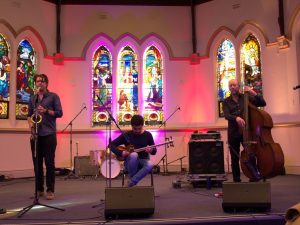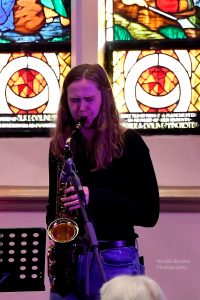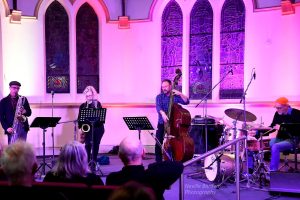June 9-11
Jazz has a way of flaring up in unexpected places – even in Orange on the far-flung Central Tablelands of New South Wales. The Orange Winter Jazz Festival was born last year, and this year’s event consisted of 40 concerts across three days in four venues. Most of the artists came from Sydney, the festival yet to be able to afford internationals.

The nominal headliners were The Necks: pianist Chris Abrahams, bassist Lloyd Swanton and drummer Tony Buck, who for 36 years have built an international fan base with hour-long improvisations that nod to both minimalism and free jazz, without sounding like either. It was fascinating to hear them somewhere else just 10 days after a Sydney Opera House concert, as few bands so adroitly utilize a given venue’s sound. Here they tamed the billowing acoustics of Orange’s Holy Trinity Cathedral, building edifices of overtones that extended the possibilities of the well-worn acoustic piano/bass/drums format.
Their music is almost heroic in its rigour and denial of self, with each player routinely sitting on an ostinato that might only evolve infinitesimally over 15 minutes or more. Yet the repetition is never to the end of stasis, but of ever-increasing tension. Each time one member changes his pattern, the effect is like a turning point in a plot. This improvisation incorporated parallel rhythmic trajectories, so the instruments spent long periods out of phase with each other, their sudden convergence producing unstoppable momentum.

The Necks have been hugely influential in Australian jazz. As Lionel Loueke has done previously, Abrahams guested with The Vampires, a band partly inspired two decades ago by Swanton’s world-beat group, The catholics, with its fondness for jaunty melodies. Trumpeter Nick Garbett, saxophonist Jeremy Rose, bassist Noel Mason and drummer Alex Masso played pieces by the horn players, hallmarks of which were coiling, intertwined melodies, and dub reggae’s extravagant use of echo. Abrahams typically found his own way into the music on Garbett’s reggae-based “Ortigara”, supplying the idiom’s trademark off-beat accompaniment one moment and improvising lines that could have been penned by Nino Rota the next—except for the saw-tooth edge to his keyboard sound. Jolting surprises broke hypnotic spells throughout The Vampires’ set.
Rose has become a pivotal figure, not just for his expert playing and composing, but because his Earshift Music is the country’s premiere jazz label. He’s also a member of another trio including a little Necks voodoo: Vazesh, with Swanton on bass and Hamed Sadeghi playing the tar, a waisted Persian lute with a sound closer to a banjo than an oud. They performed entirely improvised music in the much warmer acoustics of the Uniting Church, beginning with Rose’s solo bass clarinet delivering long, grumbling, didgeridoo-like notes and higher, plaintive cries that became a three-way conversation with tar and arco bass. The sound quality bordered on otherworldly, with Rose’s tenor so much more monumental amid these gentle musings than in The Vampires’ clutches. As Sadeghi played, the slight scrape of plectrum on string in plucking each note generated overtones that suggested a ghostly fourth instrument. Extended bass techniques, laments and nursery rhyme-like melodies were other parameters.

Both Bungarribee and the Michelle Nicole Quartet drew on western classical music. The artistry of the former, a quartet consisting of Paul Cutlan (assorted woodwinds), Gary Daley (accordion, piano, keyboard), Ollie Miller (cello, electronics) and Chloe Kim (drums), keeps growing in scope, and they began with Daley playing the cathedral’s pipe organ to gothic effect amid gusts of electronics, scraped cymbals and mournful bass clarinet. Among their adventures using classical repertoire as improvising vehicles, they visited the “Notturno” from Bartok’s Mikrokosmos Vol. IV, Bach’s “Ich glaube, lieber Herr, hilf meinem Unglauben” (which was as serene as a sunset), and a fragment from Stravinsky’s extraodinary ballet Agon—like music for marionettes—preceded by a vivd solo from Kim.
Michelle Nicole’s quartet road-tested material from their forthcoming Earshift album, The Bach Project. Occasionally their interpretations blurred the compositions’ impeccable inner logic, and pushed Nicole—a free-ranging singer with sumptuous tone and exemplary intonation—into being somewhat mannered. Two pieces were mashed with standards: “Saranbande” (from “Partita No. 1”) with “Lonely Woman”, and “Fugue in G minor” with “Round Midnight”. “March in D” was reimagined as if Ornette Coleman had written it, with flying guitar from Hugh Stuckey over textures in free time from bassist Tom Lee and drummer Ronny Ferella. When the band played at a whisper in the unkind acoustics (at least for amplified instruments) of Orange Conservatorium, it could ride the updrafts of Nicole’s voice, and she could back off the microphone, and merely frost the songs with sound.
Kim, whose drumming arrives not so much in rhythmic patterns as in energy waves, also played in the Tessie Overmyer Trio, with Overmyer (alto) and Jacques Emery (bass). The very young Overmyer is already a well-formed player and composer of some diversity, who could toughen her sound and disguise the form of her Enrolment Blues. She’s also listened widely enough to cover Frank Zappa’s charming “Little Umbrellas”—a reminder of how seldom Zappa’s dazzling compositions (especially those from 1969-72) are exploited. Overmyer’s band is one to watch.

The Sandy Evans/Andrew Robson Quartet members are close to Oz jazz royalty, essentially coming from the same generation as The Necks. Evans has been among the country’s preeminent tenor and soprano players for 40 years, while Robson has been a scalding and imaginative alto player for a decade less. In bassist Brett Hirst and drummer Hamish Stuart they have a rhythm section that can cruise like a Cadillac or bellow like a Harley Davidson, and, however loose the music becomes, this pair has a way of keeping it wedded to the hips and toes.
Some of the original pieces fizzed with rhythmic witticisms, while “The Tea Horse Road” had Robson on descant recorder and Stuart drumming with his hands, the whole building in intensity to a coarse-grained soprano solo from Evans. “Call to the Waning Moon” combined desperate cries from both saxophones, and especially affecting was an Evans tribute to the late Aboriginal singer/songwriter, Archie Roach: a piece with a slight Scottish accent and ardent solos over a slow 3/4. Where many bands look for ways to carve a niche, this one is simply at ease in its own musical skin.